
وبلاگ سپهران | Mag 26 | Whisper of Water and Music: An Overview of World’s Outstanding Fountains
Have you ever thought about the importance of fountains in enhancing the beauty of urban spaces? In this section, we overview the world’s famous fountains, from historic and majestic structures to modern and innovative designs. We take you on an exciting journey into the world of water and music, where human genius blends with nature’s most vital element, water, creating the most beautiful urban landscapes. Join us and discover stunning examples of the world’s famous fountains, uncover the stories behind their fame, and observe how these water structures have converted public areas into outstanding tourist attractions.
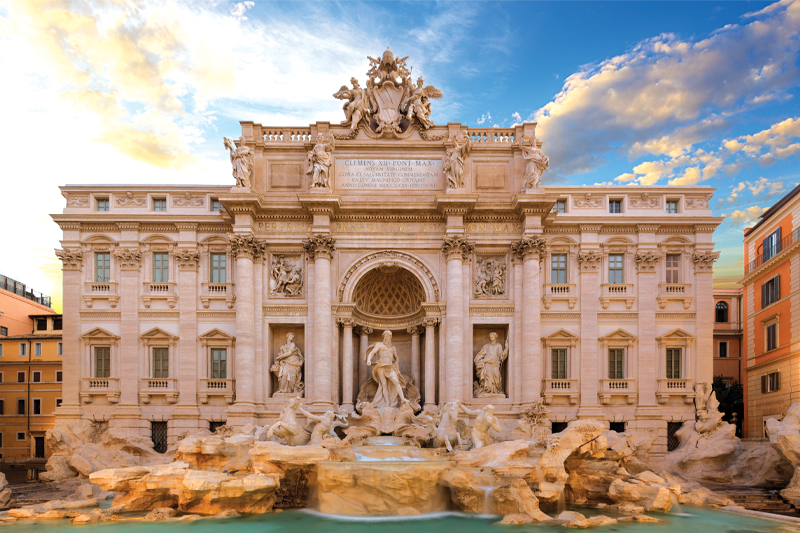
The Trevi Fountain, located in the heart of Rome, is one of the world’s most famous fountains. This creative masterpiece, designed and constructed in the Baroque style, stands as an innovative phenomenon in contrast to Greek and Roman architecture. The fountain’s original structure was an ancient aqueduct that was destroyed following the fall of the Roman Empire and remained ruined for many years. In 1629, the renowned architect, Gian Lorenzo Bernini, was commissioned by Pope Urban VIII to reconstruct the aqueduct. However, since the Pope passed away, the reconstruction of the aqueduct was left incomplete until a century later, when Pope Clement XII asked Alessandro Galilei and Nicola Salvi to propose a new design for it.
Eventually, the square was reconstructed based on Salvi’s design. It is said, that Salvi’s design for the fountain was inspired by the unfinished work of Gian Lorenzo Bernini and the designs of Pietro da Cortona, a painter and architect from Rome. The Trevi Fountain measures 26 meters in height, 20 meters in width, and 50 meters in length. It is constructed using travertine and marble stones, with the magnificent Palazzo Poli building standing prominently in the background. The statue of the Greek god of the sea and waters, Poseidon god, riding on his shell-shaped chariot, flanked by two horses, one docile and the other unruly, symbolizes the ebb and flow of the seas. The statue is accompanied by the Goddesses of abundance and health. There is a tradition that visitors throw a coin into the water with their eyes closed, hoping to return to Rome. These coins are donated to charity.

The Dubai Fountain, known globally as an expansive musical fountain, shines brilliantly in the artificial lake surrounding the Burj Khalifa, the world’s tallest building. Established in 2009 for 218 million dollars, the fountain enhances visitors’ experience with its breathtaking landscape. This fountain is famed worldwide for its extensive size, the amazing dances of lights, and its musical performances. Its awe-inspiring design presents a masterful fusion of musical tunes and dances of lights, taking the visitors away from the urban’s dazzling splendid atmosphere to an exceptionally calm location. From classical melodies to modern and even local music, each performance offers an unforgettable experience for the visitors.
Every show is a feast for you, making a unique Dubai travel memory. The fountain show is held several times throughout the night, with each performance lasting about 5 minutes. 6600 LED lights in 25 various colors, present visitors with an amazing light dance. With the water pumped up to a height of 150 meters, the fountain creates a unique combination of light, water, and music over an area of 275 meters. This performance presents one of the most beautiful urban landscapes in the world for visitors. This musical fountain is not only a popular tourist attraction, but also recognized as an innovative symbol of urban development in the modern city of Dubai. Its unique location near famous shopping centers and the Burj Khalifa creates an ideal location for enjoying nighttime activities, offering a memorable experience for visitors.
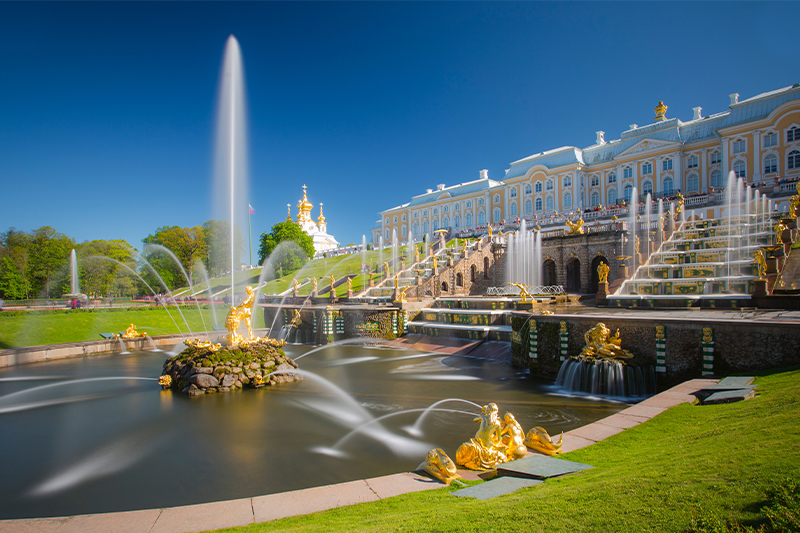
The Fountains of Peterhof Palace, like a treasure in the historical city of Saint Petersburg, invite you on a journey back to the era of the Tsars. Located 29 kilometers southwest of Saint Petersburg in the Peterhof Palace, these fountains are located in a complex encompassing 414 hectares of gardens and green spaces, often known as the “Russian Versailles”. The Peterhof Palace, with its grand fountains and luxurious gardens, leaves a magnificent impression in the minds of tourists on a journey to Saint Petersburg. The presence of 255 gilded statues and over 150 fountains is the primary reason for the beauty of this palace. The fountain complex was built in the 18th century by order of Peter the Great.
These fountains not only recall the splendor of the Tsarist Empire but are also an excellent example of human ingenuity in art and architecture. Walking through the palace gardens, one witnesses the human’s creativity, art, and ingenuity. Each fountain, with its unique designs, tells a story and depicts a part of Russian mythological history. One of the most significant features of the Peterhof Palace fountains is that they work without pumps, a remarkable innovation for its time. Visiting the Peterhof Palace is not just a trip to a historical site; it’s an adventure into an era where art and architecture served as tools to display the power and splendor of the rulers of the time. This fountain complex, utilizing aesthetic elements and the technology of its era, has created one of the most beautiful tourist attractions, offering a visit that promises an unforgettable experience.
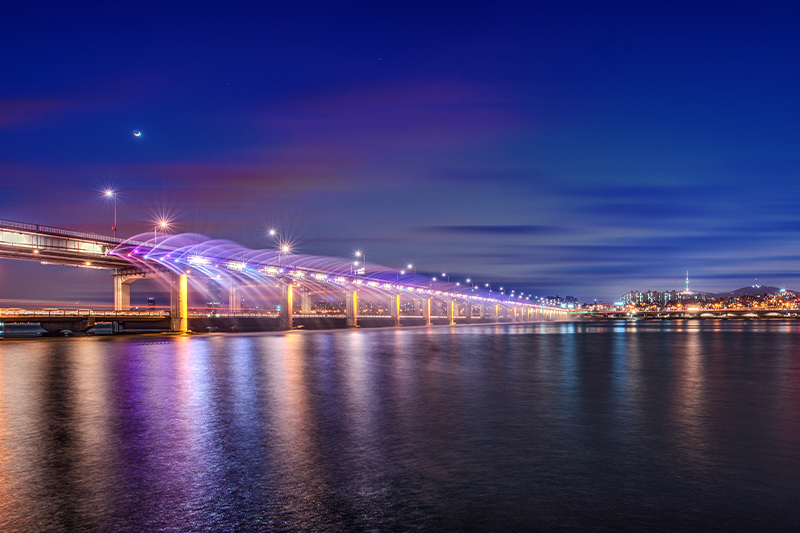
The Banpo Bridge Moonlight Rainbow Fountain in Seoul is one of the world’s most astonishing and simultaneously modern fountains. This structure, spanning over the Han River, measures 1140 meters in length and 25 meters in width, using 380 pumps to disperse 190 tons of water every minute. It proudly shines as the world’s longest bridge fountain in the Guinness Book of World Records. Watching the Moonlight Rainbow Fountain, especially at night, is more than just a simple visual display. This fountain presents a dazzling combination of light and color dance.
Covered with thousands of LED lamps, the fountain’s surface becomes an attraction where vibrant lighting intricately blends with water, creating an awe-inspiring rainbow effect under Seoul’s moonlit skies. Since its establishment as a distinctive urban landmark in 2009, this fountain has not only been a favored location for walking, cycling, and strolls but also represents a symbol of innovation in the utilization of urban public spaces. The design of this fountain is based on sustainability, and it is eco-friendly constructed, utilizing water from the Han River and ensuring its return to the same river. Visiting the Moonlight Rainbow Fountain, particularly at night, will be a memorable experience during a trip to Seoul. This fountain is not just a magnificent artistic display, but also a testament to the Seoul government’s efforts to blend aesthetic elements, technology, and environmental harmony in the heart of South Korea’s modern capital. Witnessing this fountain offers an opportunity to enjoy the unique harmony of nature and art in one of the world’s most vibrant capitals.
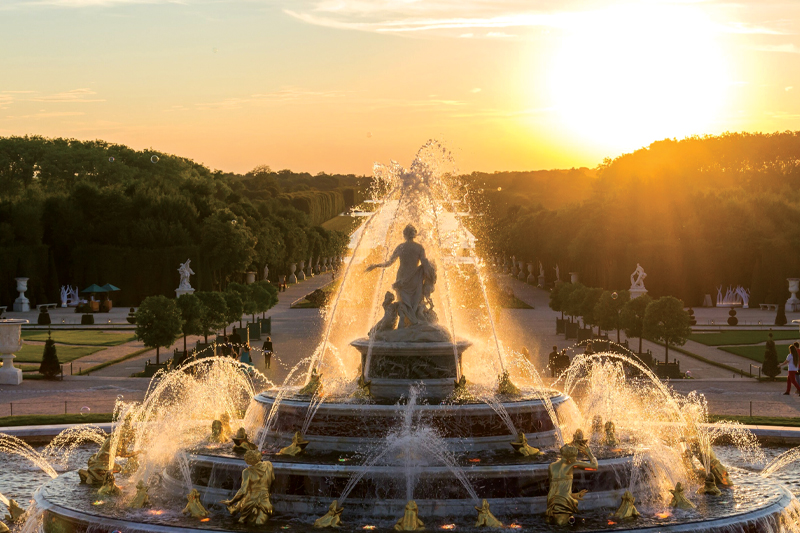
Exploring the fountains in the Palace of Versailles is more than just a simple visit. It represents a voyage through French history, art, and architecture; where the beauty and magnificence of the Baroque style blend with Greek mythology to create a unique experience for you. In French gardens, fountains are always considered the main architectural element. In the Versailles garden complex, the presence of fountains stands out more than anything else. The gardens of Versailles are designed around pathways that are either parallel or perpendicular to the royal route, creating stunningly beautiful parks. At the intersection of the four main pathways, four fountains are located, each dedicated to a different season: the fountains of spring and summer in the north and the fountains of autumn and winter in the south. From a certain point in the garden, you can view all four fountains in a single frame. On the western side of the garden, two other fountains catch your eye, depicting animals in battle with remarkable realism.
The Dragon Fountain, which represents the legend of Apollo, is the tallest in the Versailles fountain collection. The Neptune Fountain is considered an advanced hydraulic system. Initially just a pool beneath the Dragon Fountain, it now attracts attention with its statues of Neptune, Prometheus, and Oceanus. The Latona Fountain, crafted with inspiration from ancient Greek mythology, illustrates the story of Latona protecting her children from the harassment of peasants. The fountain depicting Apollo riding his chariot is also considered one of the masterpieces of Versailles. The fountain that shows Apollo riding her chariot is one of the masterpieces of Versailles, which was later completed with a magnificent statue of Apollo by the order of Louis XIV.
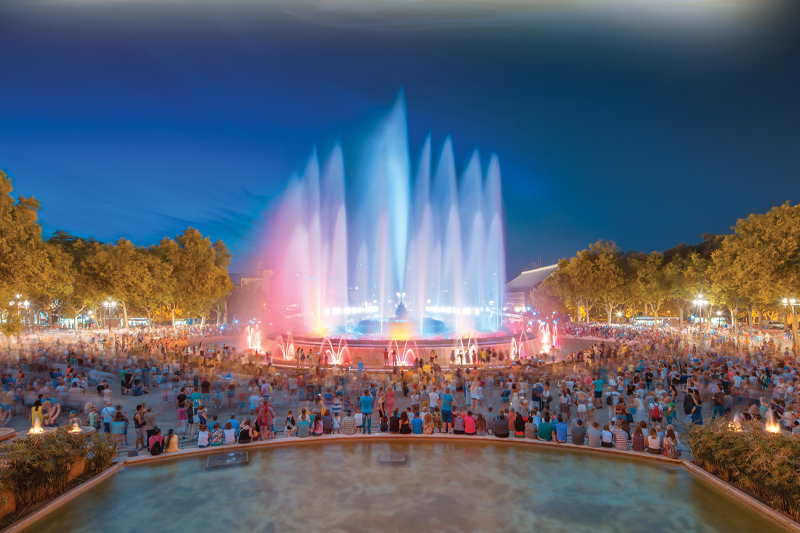
The Montjuic Magic Fountain in Barcelona was constructed for the 1929 World Fair. Later, in 1992, it was reconstructed for the Olympic Games, and since then, it has been recognized as a popular urban attraction in the beautiful city of Barcelona. Nearly a century old, this fountain draws hundreds of visitors each night to enjoy watching the dance of lights, water whispers, and music. The colorful waterfalls, in harmony with enchanting music, create a dancing rainbow that, set against the picturesque sunset of Montjuic Mountain, leaves an unforgettable image of your journey.
The operating hours of the fountain vary depending on the time of year; during the summer, the fountain show runs from Wednesday to Sunday, and during the rest of the year, from Thursday to Saturday, starting around sunset. Each performance lasts about 15 to 20 minutes. Visiting the fountain is free, and there is no need to purchase an entrance ticket. You can reserve a bike tour before heading to the lush slopes of Montjuic Mountain, which offers a spectacular view at sunset. Explore the streets of Barcelona’s old neighborhoods by bike, and allocate some time to watch the fountain. Alternatively, take a night bus tour of the city’s most famous streets, visit the Columbus monument, and enjoy the scenic views of Montjuic Mountain. Then, relax on the terrace of a nearby café, sipping a cool drink, and watching the captivating dance of light and music at the fountain.
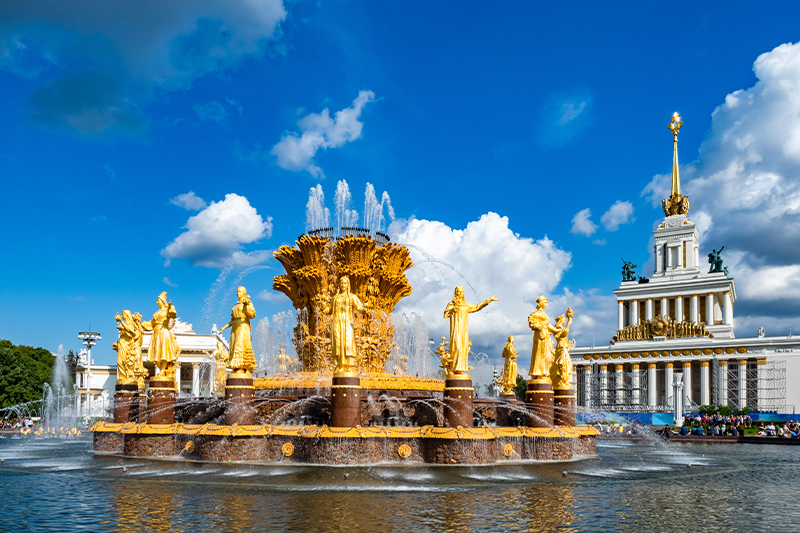
When it comes to establishing peace, harmony, and solidarity among nations, building a fountain is a brilliant idea. However, it is questionable how much this fountain has contributed to the unification of cultures and ideas. One of the most interesting things to do when visiting Russia is to visit the Friendship of Peoples Fountain in Moscow. To give the Soviet people a sense of national identity and to remind the other nations about the Soviet Nations’ unity, sixteen representatives of the former Soviet member states signed a resolution in 1954. This fountain is the symbol of that resolution, but who knew what was going to happen to that union and its people’s national identity?
Bronze maidens, each wearing their national clothing and holding a plant native to a former Soviet member state, surround the fountain. An ear of wheat is surrounded by this gorgeous circle of gilded figurines. Thousands of liters of water are spectacularly dispersed using eight pumps in a red granite basin that contains the wheat husk. These sculptures bring back memories of a bygone but influential era. This fountain was designed and built by several well-known Soviet engineers, artists, and architects. Later, in 2018 and 2019, this structure was reconstructed after being identified as a cultural heritage in Russia. To make Friendship of Peoples Fountain one of Moscow’s most stunning urban attractions, repairs were made to the fountains, frames, and structures were strengthened, and decorative features were changed.

The Fountain at the Big Wild Goose Pagoda in Xi’an, an ancient city in China, is among the largest and most famous musical fountains in the world. With their colorful lighting and the synchronization of music to the dance of light and water, the Giant Wild Goose Fountain, captivates tourists, drawing them away from the surrounding hustle and bustle for a while. The ancient Wild Goose Pagoda on the southern outskirts of Xi’an City is a Buddhist temple of the Tang Empire, and its sanctity is as significant as its antiquity. The temple resembles a large cone from the outside, but it incorporates complicated artistic details in its structure.
It is constructed from brick, and it has a very sturdy structure. Inside, stairs lead tourists to higher floors to enjoy a spectacular view of the city, surrounding areas, and the fountain. In fact, besides its religious significance and historical importance, what attracts tourists is the artistic lighting that harmonizes with the sound of music and the dance of water, creating a calm atmosphere. In the northern square of the temple, two groups of statues are located, with lanterns inscribed with Chinese poems on their bodies. As sunset falls and the moon rises, a gentle light takes over the square. The fountain stretches 218 meters from west to east, and 346 meters from north to south. Near the temple and its stunning fountains, there are resting areas that are free for tourists. The best of these resting places are located in the northern square, offering a spectacular view of the temple’s musical fountains.